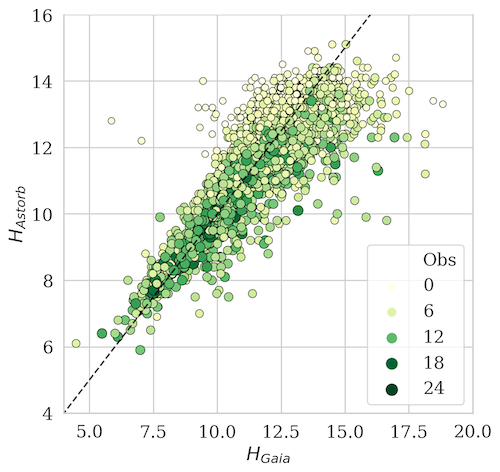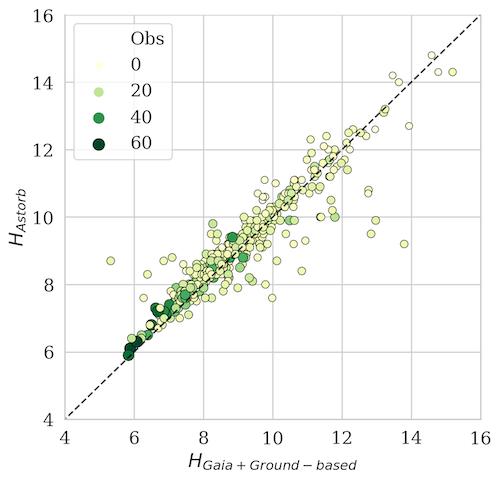H-G determination of 4000 asteroids from GAIA-DR2
- 1Instituto de Astronomía Teórica y Experimental (CONICET-UNC), Córdoba, Argentina
- 2Facultad de Matemática, Astronomía, Física y Computación, Universidad Nacional de Córdoba (UNC), Córdoba, Argentina
- 3Instituto de Astrofisica de Andalucia, Solar System, Granada, Spain
The Gaia mission will provide to the solar system scientific community with high quality observations of about 300,000 asteroids of all categories. Most will be from the main belt but small asteroids from the NEA group, Jupiter trojans, centaurs and transneptunians are also observed. Gaia Data Release 2 (DR2) was published in 2018 and consists of 22 months of observations of 14,099 known Solar System objects, mainly asteroids [2], based on more than 1.5 million observations (https://www.cosmos.esa.int/web/gaia/data-release-2). The scientific community must be prepared to analyze this large amount of data that will allow us to encompass a more detailed knowledge of asteroid populations, which are currently poorly characterized, since basic physical properties such as mass, density, rotation properties, shape and albedo are not yet known for most of them [1].
The purpose of this work is to obtain a catalogue of phase function parameters (H and G) for all asteroids that are observed by the Gaia mission and published in DR2.
To do this, we introduce an algorithm capable of building this catalogue from the magnitude and julian date data present in the Gaia mission DR2. For a first stage of testing, we started with those objects whose MPC number is less than 5000. Since Gaia will never observe asteroids at 0o phase angle (corresponding to the opposition), but at phase angles greater than 10o, we added data from ground-based observations (corresponding to small phase angles) and thus improved the determination of the H and G parameters of the phase function. As a next step in the search to improve this determination, we repeat the calculations for the phase function of three parameters H, G1 and G2 [4] .
We obtained a catalogue with the estimation of the parameters two parameters of the phase functions (H and G) for 4208 asteroids (Figure 1). We compared our results with those in the Astorb database and noted that the level of agreement is satisfactory. In Figure 1 we can see the comparison of the obtained H versus the one published in the Astorb database. Furthermore, it is important to note the decrease of about 50% in the mean square error after combining the Gaia mission data with photometric data obtained from the ground (Figure 2). Data from the ground is obtained from the Asteroid Photometric Catalog V1.1 [3].

Figure 1: Comparison of the obtained H using Gaia data only versus the one published in the Astorb database. The colour scale indicates the number of GAIA observations, the darker the colour, the more observations the asteroid has.

Figure 2: Comparison of the obtained H using Gaia data and data obtained by ground-based telescopes versus the one published in the Astorb database. The colour scale indicates the number of GAIA observations as before.
We also obtained the G parameters for those 4208 asteroids (Figure 3). It is important to note that asteroids have G values in a wide range, as opposed to the fixed value G=0.15 that is assigned to most of them as established in MPC 17257 (December, 1990).
Figure 3: Histograms of the G-values obtained. The vertical green line marks G=0.15, which is the value adopted for the vast majority of asteroids.
We must be prepared with computer tools to analyze and take advantage of the large amount of data that the Gaia mission will provide to the scientific community in DR3. With our work we will not only be contributing with the catalogue of parameters of the phase function but also, we will be able to estimate the diameters of the thousands of observed asteroids using the obtained absolute magnitudes H combined with the information of the albedos of these objects.
We highlight here the importance of been prepared to analyze all the data coming from the space and ground-based surveys. Special dedication to the preparation of dedicated pipelines to extract all the possible information in each survey.
REFERENCES
[1] Gaia Collaboration et al. “Gaia Data Release 2. Observa- tions of solar system objects”. In: 616, A13 (Aug. 2018), A13. doi: 10.1051/0004-6361/201832900. arXiv: 1804. 09379 [astro-ph.EP].
[2] Daniel Hestroffer et al. “The Gaia Mission and the As- teroids”. In: Lecture Notes in Physics, Berlin Springer Verlag. Ed. by J. Souchay and R. Dvorak. Vol. 790. 2010, pp. 251–340. doi: 10.1007/978-3-642-04458-8_6.
[3] C. -I. Lagerkvist and P. Magnusson. “Asteroid Photo- metric Catalog V1.1”. In: NASA Planetary Data System, EAR-A-3-DDR-APC-LIGHTCURVE-V1.1 (Sept. 2011), EAR-A-3-DDR-APC-LIGHTCURVE–V1.1.
[4] Karri Muinonen et al. “A three-parameter magnitude phase function for asteroids”. In: 209.2 (Oct. 2010), pp. 542–555. doi: 10.1016/j.icarus.2010.04.003.
How to cite: Colazo, M. and Duffard, R.: H-G determination of 4000 asteroids from GAIA-DR2, Europlanet Science Congress 2020, online, 21 September–9 Oct 2020, EPSC2020-406, https://doi.org/10.5194/epsc2020-406, 2020

